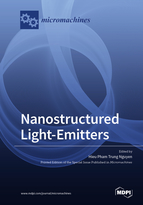Nanostructured Light-Emitters
A special issue of Micromachines (ISSN 2072-666X). This special issue belongs to the section "A:Physics".
Deadline for manuscript submissions: closed (30 November 2019) | Viewed by 64347
Special Issue Editor
Interests: nanostructures; epitaxial growth; nanophotonics; light-emitting diodes; laser diodes; solid-state lighting; micro-displays
Special Issues, Collections and Topics in MDPI journals
Special Issue Information
Dear Colleagues,
Significant progress has been made in nanophotonics and the use of nanostructured materials for optoelectronic devices, including light-emitting diodes (LEDs) and laser diodes, which have recently attracted considerable attention due to their unique geometry. Nanostructures in small dimensions, comprising nanowires, nanotubes, and nanoparticles, etc,. can be perfectly integrated into a variety of technological platforms, offering novel physical and chemical properties for high-performance, light-emitting devices.
The exploitation of new nanostructures for light-emitting devices and their optical/electrical properties is necessary for their emerging practical device applications. For instance, III-nitride nanowires offer several distinct advantages including being nearly-free of dislocations and a polarization field, which results in the enhanced efficiency and output power of LEDs with an emission wavelength that can be varied from deep ultraviolet to near infrared. Two-dimentional nanomaterials, as well as nanoplasmonics, can be used efficiently to enhance light absorption and emission in optoelectronics devices.
This Special Issue aims to present the most recent advances in the field of nanophotonics, which focuses on LEDs and laser diodes. We invite contributions of original research articles, as well as review articles that are aligned to the following topics that include, but are not limited to, thetheoretical calculation, synthesis, characterization, and application of such novel nanostructures for light-emitting devices. The application of nanostructured light-emitters in general lighting, imaging, and displays is also highly encouraged.
Dr. Hieu Pham Trung Nguyen
Guest Editor
Manuscript Submission Information
Manuscripts should be submitted online at www.mdpi.com by registering and logging in to this website. Once you are registered, click here to go to the submission form. Manuscripts can be submitted until the deadline. All submissions that pass pre-check are peer-reviewed. Accepted papers will be published continuously in the journal (as soon as accepted) and will be listed together on the special issue website. Research articles, review articles as well as short communications are invited. For planned papers, a title and short abstract (about 100 words) can be sent to the Editorial Office for announcement on this website.
Submitted manuscripts should not have been published previously, nor be under consideration for publication elsewhere (except conference proceedings papers). All manuscripts are thoroughly refereed through a single-blind peer-review process. A guide for authors and other relevant information for submission of manuscripts is available on the Instructions for Authors page. Micromachines is an international peer-reviewed open access monthly journal published by MDPI.
Please visit the Instructions for Authors page before submitting a manuscript. The Article Processing Charge (APC) for publication in this open access journal is 2600 CHF (Swiss Francs). Submitted papers should be well formatted and use good English. Authors may use MDPI's English editing service prior to publication or during author revisions.
Keywords
- Nanostructured photonics
- Nanophotonics
- Low-dimentional semiconductors
- Light-emitting diodes
- Laser diodes
Related Special Issue
- Nanostructured Light-Emitters, Volume II in Micromachines (5 articles)







